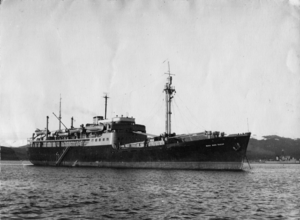ARA Bahía Buen Suceso

| |
| History | |
|---|---|
| Name | Bahía Buen Suceso |
| Builder | Halifax Shipbuilding Ltd., Halifax, Nova Scotia |
| Yard number | 17 |
| Commissioned | 1950 |
| Identification | Call sign : LOPQ |
| Fate | Sunk, 21 October 1982 |
| General characteristics [1] | |
| Tonnage | 3,834 gross register tons (GRT) |
| Length | 102.48 m (336 ft 3 in) |
| Beam | 14.36 m (47 ft 1 in) |
| Draught | 5.64 m (18 ft 6 in) |
| Propulsion | 2 × Nordberg 5-cylinder 3,750 hp (2,796 kW) diesel engines, 2 shafts |
| Speed | 14.5 knots (26.9 km/h; 16.7 mph) |
| Capacity | 100 passengers |
| Crew | 46 |
| Service record | |
| Part of: | ARA Naval Transport Service |
| Operations: | Falklands war |
ARA Bahía Buen Suceso (B-6) was a 5,000-ton fleet transport that served in the Argentine Navy from 1950 to 1982. She took part of the Falklands War (Template:Lang-es) as a logistics ship tasked with resupplying the Argentine garrisons scattered around the Falkland Islands. Captured by British forces on 15 June after running aground at Fox Bay, she sank in deep waters while being used as target practice by the Royal Navy on 21 October 1982.
History
The ship was constructed by Halifax Shipbuilding Limited at Halifax, Nova Scotia, Canada, and commissioned in June 1950 for service under the Transporte Navales command. In 1958 she carried the crew of the new aircraft carrier ARA Independencia to the United Kingdom. The vessel participated in numerous Antarctic supply missions. On 10 March 1969 she made a trip to Europe, visiting cities such as Genova, Brugge, Rotterdam, Amsterdam, Portsmouth, Edinburgh, and Dublin. The purpose of the trip was to carry wheat to Europe and bring military items to Argentina. While sailing through the English Channel, she collided with the tanker Asprella and was repaired at the Ferrol shipyard in Vigo, Spain. In 1972 she began regular service between the continent and the Falkland Islands.[2]
Falklands war
The ship landed scrap-metal workers on South Georgia on 19 March 1982. She was involved in the blockade running to the Falkland Islands. She sailed from Stanley towards Falklands Sound on 29 April, before the first British attack. While heading to the south on 6 May, the ship spotted the schooner Penelope, property of the Falkland Islands Company, at anchor along a pier in Speedwell Island. The small craft was taken over by an Argentine prize crew the following day.[3] While berthed in Fox Bay East on West Falkland, she was attacked by two BAe Sea Harrier FRS.Mk.1s (XZ500 and ZA191) from HMS Hermes. Because the ship was so close to private homes, the Sea Harriers used their 30 mm ADEN cannons rather than general-purpose bombs. They damaged the ship's bridge and engine room, and set fire to a paint store and workshop ashore. One of the Sea Harriers was hit in the tail by a 7.62 mm bullet while strafing the transport; the aircraft was able to return to Hermes safely.[4]
After the attack the ship did not sail again and remained moored in Fox Bay East. During a storm, she partially tore loose from her moorings and the bow swung onto the beach. After the war, Bahía Buen Suceso was towed to San Carlos Water by the tug Irishman. Her cargo of ammunition was unloaded. On 21 October 1982 her hull was towed out to deep water where it was sunk by a combination of naval gunfire and fire from Sea Harrier FRS.Mk.1s from 809 Naval Air Squadron. The ship was also hit by a torpedo from the submarine HMS Onyx.
See also
References
Notes
- ^ "Transportes Navales : "Bahia Buen Suceso" 1950-1982". histarmar.com.ar (in Spanish). Archived from the original on 26 January 2010. Retrieved 8 June 2010.
{{cite web}}: Unknown parameter|deadurl=ignored (|url-status=suggested) (help) - ^ "Historia y Arqueologia Marítima - Bahia Buen Suceso". histarmar.com.ar (in Spanish). Retrieved 19 November 2016.
- ^
Mayorga, Horacio A. (1998). No Vencidos (in Spanish) (Planeta ed.). Buenos Aires. p. 313. ISBN 950-742-976-X.
{{cite book}}: CS1 maint: location missing publisher (link) - ^ Morgan, David. "Chapter 6". Hostile Skies. Phoenix. p. 142. ISBN 978-0-7538-2199-2.
as a hole from a 7.62 millimetre rifle bullet was found in his tail
Bibliography
- Hobson, Chris. Falklands Air War. ISBN 1-85780-126-1.
External links
- History of the ship at Falklands War Template:Es icon
- Photos of the ship 1 (Archived 2009-10-24)
- Photos of the ship 2 (Archived 2009-10-24)
- Photos of the ship 3 (Archived 2009-10-24)
- Photos of the ship 4 (Archived 2009-10-24)
- Cold War auxiliary ships of Argentina
- Transports of the Argentine Navy
- Ships built in Nova Scotia
- Shipwrecks of the Falklands War
- Falklands War in South Georgia
- Falklands War naval ships of Argentina
- Ships sunk as targets
- Maritime incidents in 1969
- Maritime incidents in 1982
- 1950 ships
- Ships sunk with no fatalities
